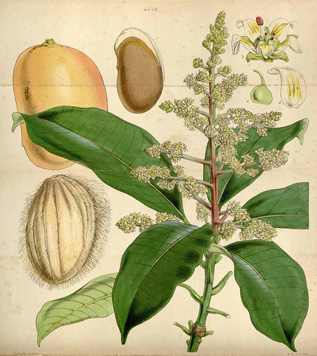Munificent Mango
By Audrey Stallsmith

Each tender purple mango shoot,
That folds and droops so bashful down;
It lives; it sucks some hidden root;
It rears at last a broad green crown.
It blossoms; and the children cry,
"Watch when the mango-apples fall."
It lives: but rootless, fruitless, I--
I breathe and dream--and that is all.
from “The Mango Tree” by Charles Kingsley
I bought a mango fruit when they were on sale this winter, mainly just so I could try starting a tree from the seed. Although we did eat the flesh, its somewhat pine-y flavor remains a bit off-putting to me, while the propensity of much of that flesh to cling to the pit also is annoying. Especially so, when you want to pry open that pit!
Although it was a messy job, I was able to insert the point of a knife into the indentation on one end of the pit, and gradually force it open to reveal the embryo inside. That embryo already was putting out a bit of root, so I placed it inside a damp paper towel until it also sent out a leafy shoot. I then potted it up and it now is a tiny tree a couple inches tall with red-tinged glossy leaves.
Despite what I perceive as their deficiencies, mangoes (Mangifera indica) are among the most popular fruit trees in the tropics. Perhaps I got one of the cheaper cultivars, which The New Sunset Western Garden Book calls “stringy” and having “a flavor reminiscent of varnish.” That volume describes the flavor of better quality mangos as “like a peach with flowery overtones.” As with most fruits, I imagine they taste better when allowed to ripen on the tree, too, rather than being picked green for shipping.
Hardy only as far north as zone 10b, in the U. S. mangoes generally will only fruit in Hawaii, south Florida, and our tropical territories such as Puerto Rico and Guam. So I’m not expecting to get any produce out of mine, just an attractive houseplant. Although mangoes were imported into the U. S even before it was the U.S.—in the 1600s—back then only the pickled ones could make such a voyage without spoiling.
Mango fruits are oblong or round and generally yellow or green with a red tinge, though there are red and purple cultivars as well. The trees bloom in March or April in Florida with large panicles of pinkish-cream or greenish-yellow flowers.
In Kingsley’s poem about the tree, which I quote at the beginning of this article, a young military widow of the 1800s—probably a British widow in India—loses her husband and all three children to the “fever.” She understandably resents the rude good health of the mango tree beneath which they lie.
Those trees can, indeed, be very vigorous in their native south Asia, sometimes surpassing 100 feet in height and living for hundreds of years. Most populous in India, they derive their name from the Malayalam word “manna” and are as important in Indian folklore and culture as the apple is to us North Americans.
Although the Malayalam pronunciation of “manna” probably is different than ours, I imagine mangoes can, indeed, be manna for the poor in tropical countries. Some trees produce two crops a year, and the nutritious fruits are edible when green, though still tart then. Higher in Vitamin C than citrus fruits are, they also are rich in beta carotene, folate, fiber, and antioxidants. You’ll want to be careful when pruning the trees, though, since their sap—like that of the cashew and sumac to which they are related—can raise a poison-ivy-like rash on the skin.
A favorite trick of India’s magicians used to be causing a mango tree to sprout from the ground within minutes. Although the trees do grow pretty quickly from seed, they aren’t quite that quick!
A photographer who once attempted to capture the sleight of hand on film claimed that the tree didn’t show up in his photo, so that the magician must just have mesmerized his viewers into believing it was there. I say the real trick is getting those slippery seeds open without damaging either your fingers or the embryos!
Mangifera indica image is from Curtis's Botanical Magazine, courtesy of plantillustrations.org.








